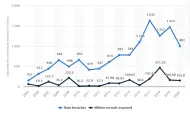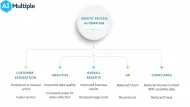Top 10 Business Processes an RPA Chatbot Automates in 2024
With the advent of ChatGPT, we expect more companies to use chatbot technology to automate repetitive tasks across the back office and the front office. One of these technologies is RPA chatbots.
In this article, we will explain how integrating robotic process automation (RPA) into chatbots can improve business processes. Note that the use cases mentioned in this article aren’t comprehensive just yet. We will keep updating the list.
What is RPA?
RPA, or robotic process automation, is a technology to automate tasks via software robots, or bots. Companies in different industries have leveraged RPA due to complete repetitive processes without human intervention.
Explore RPA 100+ use cases in more detail.
What are chatbots?
Chatbots leverage conversational AI to chat with humans. Chatbot technology is used in various industries. The benefits of chatbots are their 24/7 availability and fast response rate to resolve common queries, both externally and internally.
What is the difference between chatbots and RPA?
Chatbots understand natural language, find the answer from their knowledge bases, and give it to the user. For instance, in customer facing scenarios, a chatbot could direct the customer to the “refund policy” webpage if asked.
RPA would receive requests, or be scheduled to, execute tasks in a business process. For instance, in insurance, RPA bots can review an insurance claim to determine its legitimacy.
What are RPA chatbots?
RPA chatbots are chatbots that are powered by RPA robots for enhanced performance. A main limitation of basic chatbots is that they can only answer questions; they can’t execute tasks.
RPA technology would enable the chatbot to:
- Recognize user intent
- Provide relevant information
- Complete certain tasks
Which would have otherwise been performed manually. Going back to our “refund policy” example, an RPA chatbot could both direct the customer to the relevant page, but also open a refund ticket.
Note that RPA chatbots excel at back-office processes as well. But if used internally, they would take the form of a virtual assistant where the employee would input a command within a conversational interface, and the chatbot would execute the tasks. For example, they would ask the chatbot to “give the customer reports for August.” The RPA chatbot would then pull the relevant data from the appropriate systems and return it.
What are the use cases of RPA chatbots?
Customer service
1.1. Account opening
Chatbots can do the preliminary steps of new account opening. The customers, instead of robotically filling out a form, can speak with the chatbot. Info such as their name, age, etc. would be recorded and put onto forms.
1.2. Complaints/suggestion management
Users can tell the chatbot their complaints and suggestion about the company’s products and services. The natural language processing (NLP) capability enables the chatbot to understand the user intent. The RPA chatbot would then either save the ticket and pass it onto the relevant rep, or directly connect the customer with customer service.
1.3. Return & refund processes
The RPA chatbot could improve the customer experience by helping customers initiate the return/refund process in one window, without having to navigate through different systems. Especially given that if a customer’s intent is on returning or getting a refund, then chances are they are already less than satisfied with their experience with the brand. So it’s important to not make it harder than it needs to be.
The chatbot could ask the customer why they are unhappy with the product, determine if they’re eligible for a return/refund, and initiate the workflow automatically, such as emailing them the shipping label, asking them to verify their credit card number to receive the refund, and more.
Explore RPA use cases in customer service in more details.
Sales
2.1. Product recommendation
Upon visiting a website, the RPA chatbot can ask questions from the visitor about the reason for visiting, their needs, and recommend the products that they might be interested in.
And if the visitor is an existing customer, the artificial intelligence capability allows the RPA chatbot to curate a recommended list of products without the chit-chat.
Learn more about recommendation systems.
2.2. Data management
In the back office, employees can ask the chatbot to bring up the data on a certain customer, without them having to manually search for it. In insurance, for instance, the insurance rep can quickly pull up the customer’s policy information by conversing with the chatbot.
Explore data management automation in more detail.
2.3. Report generation
Employees can ask the RPA chatbot to create a report on a client’s customer journey, financial performance, complaints management effectiveness, etc. without needing to initiate a workflow via UI interaction.
Learn more about RPA use cases in reporting.
2.4. Order submission
Especially in the hospitality industry, where the requests are binary (i.e., “book a room,” “reserve a seat,” “hotel room with ocean view”) RPA chatbots can automate customer-facing sales processes such as order placement, accommodation requests submission, etc.
- Learn more about RPA use cases in hospitality industry and RPA in sales.
- Explore order management automation in more detail.
HR
3.1. Hiring and onboarding
HR teams can use RPA chatbots in the hiring process. The bot would ask questions from the candidate, record their answers, and put it in the database or in legacy systems. Moreover, when a new employee is hired, they can ask the chatbot questions, request documents, etc.
Learn more about employee onboarding automation.
3.2. Satisfaction surveys
For end of the year surveys, chatbots can replace generic forms for asking and recording questions. Moreover, depending on their answers, or the department that the employees work in, the chatbot, thanks to the machine learning algorithms, can ask specific, relevant follow up questions.
3.3. Contract management
HR teams can use the intelligent automation found in chatbots to quickly access the data on employees’ contracts without manually having to extract it.
- Learn more about RPA use cases in HR.
- Learn more about contract automation.
How to Integrate Robotic Process Automation and Chatbots?
There’s nothing special that users have to do to integrate RPA into a chatbot. Vendors, such as IBM, already offer conversational ai capabilities in their RPA software. So you don’t need any integration work.
For more on RPA & chatbots
If you are interested in investing in RPA and/or chatbots, head over to our data-driven lists of:
We will help you through your selection process:

Cem has been the principal analyst at AIMultiple since 2017. AIMultiple informs hundreds of thousands of businesses (as per similarWeb) including 60% of Fortune 500 every month.
Cem's work has been cited by leading global publications including Business Insider, Forbes, Washington Post, global firms like Deloitte, HPE, NGOs like World Economic Forum and supranational organizations like European Commission. You can see more reputable companies and media that referenced AIMultiple.
Throughout his career, Cem served as a tech consultant, tech buyer and tech entrepreneur. He advised businesses on their enterprise software, automation, cloud, AI / ML and other technology related decisions at McKinsey & Company and Altman Solon for more than a decade. He also published a McKinsey report on digitalization.
He led technology strategy and procurement of a telco while reporting to the CEO. He has also led commercial growth of deep tech company Hypatos that reached a 7 digit annual recurring revenue and a 9 digit valuation from 0 within 2 years. Cem's work in Hypatos was covered by leading technology publications like TechCrunch and Business Insider.
Cem regularly speaks at international technology conferences. He graduated from Bogazici University as a computer engineer and holds an MBA from Columbia Business School.
To stay up-to-date on B2B tech & accelerate your enterprise:
Follow on

Comments
Your email address will not be published. All fields are required.